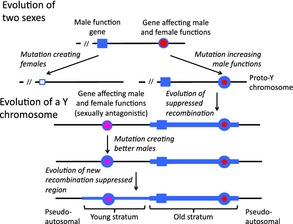Figure 2.

The evolution of separate sexes from an initial hermaphrodite. As in the case of a mimetic morph, two sexes could evolve by two or more changes. The first mutation creates females (symbolized by a change from a large filled blue square to a small open square), and subsequent mutations at two loci (circles) increase the male function of the nonfemale individuals (those with the large filled blue square allele), while decreasing their female functions (symbolized by increased amounts of blue and smaller amounts of red colouring of the alleles present at these loci). These mutations can be regarded either as female suppressors or as modifiers of the balance between male and female functions. There is thus similarity with the model for the evolution of Batesian mimicry in Fig. 1A, with modifiers that are expressed regardless of the individuals’ gender (rather than specifically in individuals with one morph/sex, as in Fig. 1B). The chief difference from the Batesian mimicry case is that, in the evolution of mimicry, both mutations occur on the same ‘mimicry haplotype’, whereas, in the case of separate sexes, the male‐sterility mutation (creating females) occurs in a male function gene carried on one member of a homologous chromosome pair, while the male‐promoting/female‐suppressing mutations must occur on the other homolog, otherwise a sterile phenotype would be produced, causing the selective loss of the second mutation.
